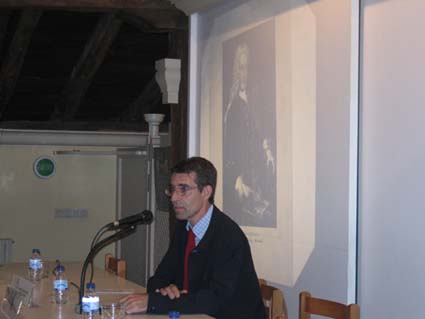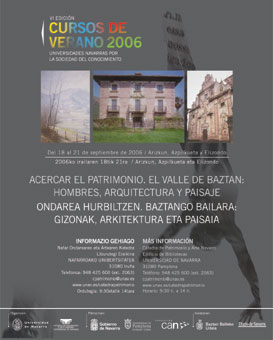BRINGING HERITAGE CLOSER. THE BAZTAN VALLEY: MEN, ARCHITECTURE AND LANDSCAPE
September 18, 2006
Juan de Goyeneche, ahead of his time.
Dr. Alfredo Floristán Imízcoz. University of Alcalá de Henares

Don Juan de Goyeneche y Gastón (Arizcun 1656- Madrid 1735) was, most probably, the most influential Navarrese at the court of Philip V of Bourbon during the first third of the 18th century. Others before him had reached, at certain moments, higher levels of political power next to the kings of the House of Austria, but never so much influence and, above all, so much wealth. And none like him made such a lasting impression on his contemporaries, nor aroused so much admiration in later generations, even up to the present day. He personifies, like no other, the "Navarrese hour of the 18th century": the success staff of several dozen financiers, governors and bureaucrats of Navarrese origin, who excelled in Spain and the Indies as never before.
And this, from relatively humble origins, of which we know little. At the court of Charles II, where he emigrated while still a teenager, he began as the obscure treasurer of the king's secret expense . He received a careful Education and cultivated humanistic study and patronage, while aligning himself among the early reformers. Around 1700, the War of Succession turned him into an active businessman, both as an army retainer and as a lessor of royal rents. Don Juan de Goyeneche was the center -perhaps the driving force- of a powerful network of financiers of Navarrese and Basque origin who took advantage of the change of dynasty to occupy prominent positions in the revenue administration of the new Bourbon Spain. Among his many companies and projects, his work as a creator of industries earned him an everlasting fame among his contemporaries. Near Alcalá de Henares, in Madrid, he promoted a new town, with which he wanted to remember his origins, which he called "Nuevo Baztán".
He gave rise to a relevant dynasty adorned with noble titles (Marquis of Belzunce and Ugena, Count of Saceda) and gradually moved away from the financial and industrial business, to occupy court or government positions. His "main house" in Madrid -today the seat of the Royal Academy of Fine Arts of San Fernando- and the urban complex of Nuevo Baztán, both works of his friend José de Churriguera, testify to the original breadth and dynamism of his economic enterprises, whose most modernizing features have not gone unnoticed.

PROGRAM
MONDAY, 18 SEPTEMBER
Place: Elizondo. Arizkunenea Cultural Centre
16.45 h: Opening and presentation of the course
17 h. Juan de Goyeneche, ahead of his time
Prof. Dr. Alfredo Floristán Imízcoz. University of Alcalá de Henares
18 h. Coffee break
18.30 h. Ziga, Lekaroz and Gartzain: the churches of the Renaissance in the Baztan area
Prof. Dr. María Josefa Tarifa Castilla. Chair of Navarrese Heritage and Art
TUESDAY, 19 SEPTEMBER
Place: Elizondo. Arizkunenea Cultural Centre
17 h. From the village to the Court
Prof. Dr. José María Imízcoz Beunza. University of the Basque Country
18 h. Coffee break
18.30 h. Palaces of Baztan
Prof. Dr. Pilar Andueza Unanua. Chair of Navarrese Heritage and Art
Then visit to the Ethnographic Museum of Baztan Jorge Oteiza, guided by Ms. Ana María Marín, member of the Friends of the Museum.
WEDNESDAY, 20TH SEPTEMBER
Place: Arizkun. Convent of the Poor Clares
17 h. Juan Bautista Iturralde and his foundations
Prof. Dr. María Concepción García Gainza. Chair of Navarrese Heritage and Art
Place: Azpilkueta. Parish
18.30h. Families and artistic promotion: Elizacoechea in Azpilkueta, the Jáuregui family in Oharriz
Prof. Dr. Ricardo Fernández Gracia. Chair of Navarrese Heritage and Art
THURSDAY, 21ST SEPTEMBER
Place: Elizondo. Arizkunenea Cultural Centre
17 h. Indian art and architecture in the Baztan Valley. The 19th and 20th centuries
Prof. Dr. Javier Azanza López. Chair of Navarrese Heritage and Art
18 h. Coffee break
18.30 h. Closing session: The Bidasoa School and landscape painting in Baztania.
Prof. Dr. Francisco Javier Zubiaur Carreño. Museum of Navarre
